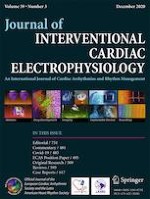Erschienen in:

24.12.2019 | Transesophageal Echocardiography
Use of a radiofrequency guidewire to simplify workflow for left atrium access: a case series
verfasst von:
Gaël Jauvert, Caroline Grimard, Christine Alonso, Arnaud Lazarus
Erschienen in:
Journal of Interventional Cardiac Electrophysiology
|
Ausgabe 3/2020
Einloggen, um Zugang zu erhalten
Abstract
Purpose
Transseptal puncture (TSP) is widely used in catheter-based cardiac procedures to gain left atrial access, but its workflow has remained largely unchanged in the last 50 years. This study evaluated the safety and efficacy of a novel, simplified technique for TSP with a radiofrequency (RF)-powered guidewire that eliminates multiple exchanges required with standard needles.
Methods
TSP was performed in 84 patients undergoing left-sided procedures (72 atrial fibrillation ablations [32 RF, 40 cryoballoon], 4 atrial tachycardia ablations, 2 ventricular arrhythmia ablations, 6 left atrial appendage closure) utilizing a stiff, exchange length RF guidewire. Under fluoroscopic and echocardiographic guidance, the RF guidewire was used to facilitate septal puncture with RF energy and provide a rail for advancing catheters to the left atrium without exchange. All procedures were performed under general anesthesia or sedation.
Results
TSP was achieved in all patients with no complications. The RF guidewire allowed catheters to be tracked back up to the superior vena cava without exchange in cases where another dropdown was desired to locate a preferred puncture site. The stiffness of the wire provided adequate support to advance all sheaths to the left side regardless of outer diameter.
Conclusion
TSP was performed safely and successfully for various left heart procedures with a RF guidewire that served as an RF transseptal device and a stiff guidewire. This allowed for a more efficient and potentially safer technique without the need for re-wiring or an over the wire sheath exchange. This provides substantial savings in both time and materials.











